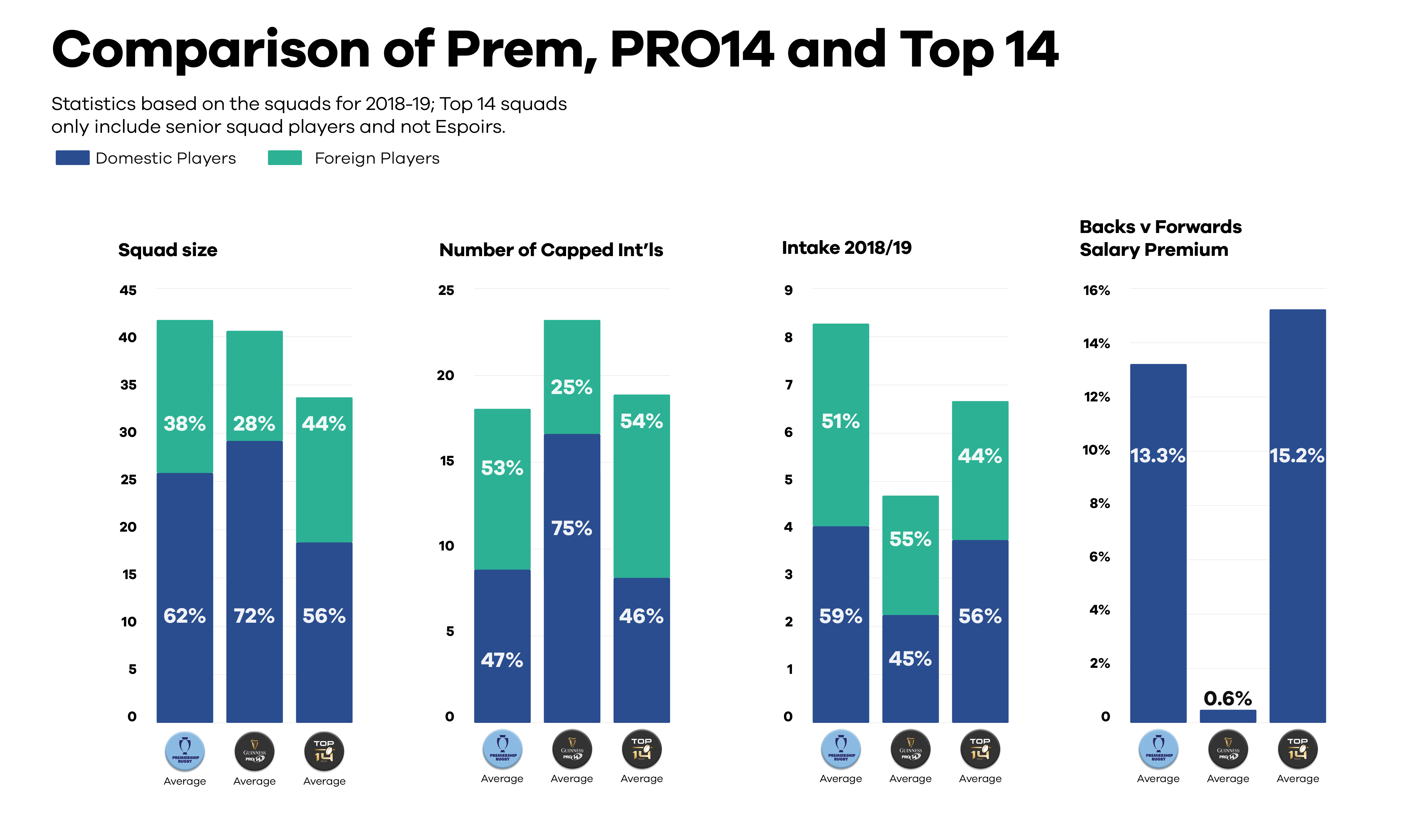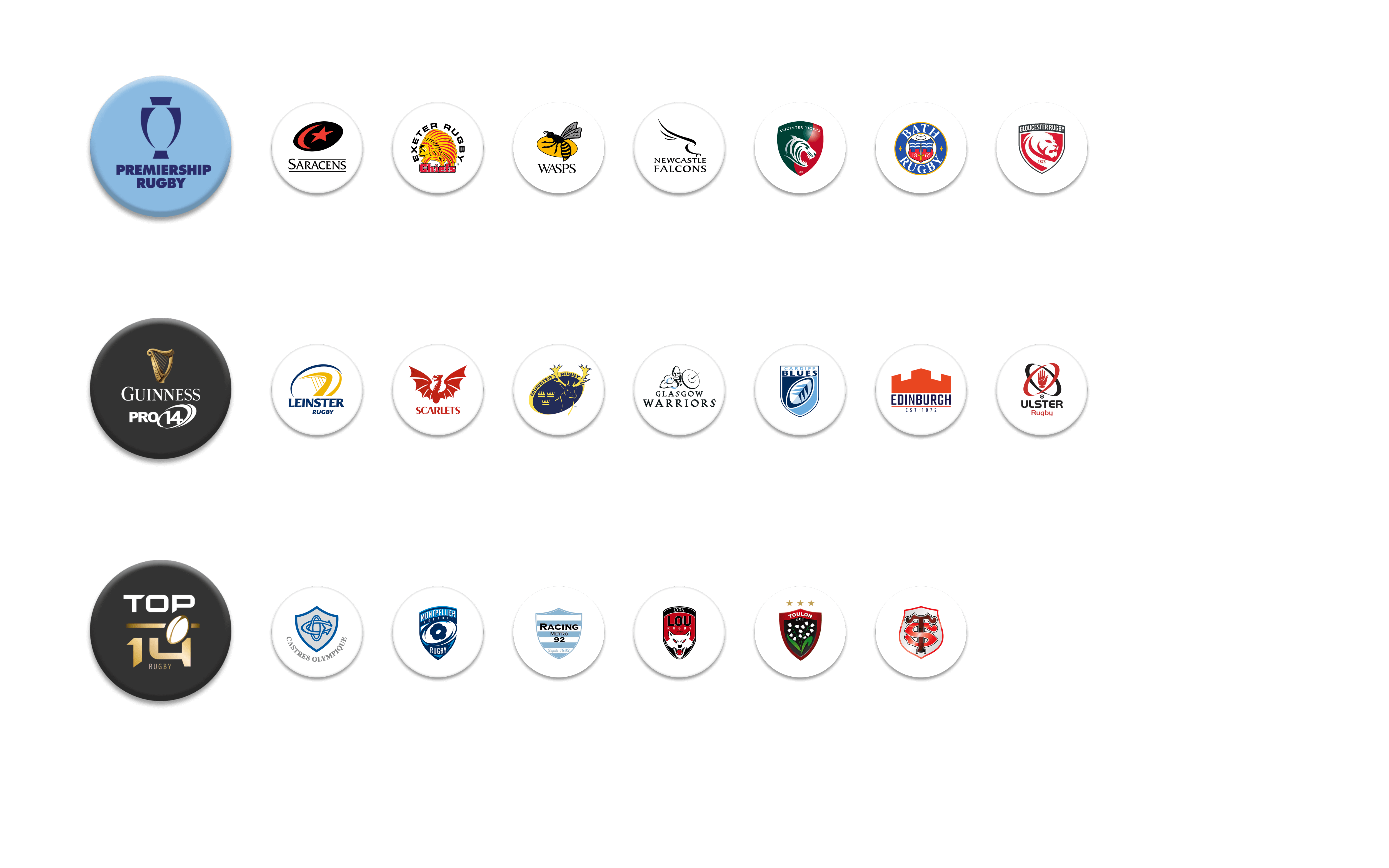

Here we compare and contrast some key attributes of Premiership, PRO14 and Top 14 squads in the 2018-2019 Heineken Champions Cup.
The first obvious variation is age with both Premiership and PRO14 clubs having roughly the same average squad ages (26.7 and 26.2), while the Top 14 clubs, in comparison, have a much higher average squad age. That is, a full 2 years more experienced than PRO14 clubs on average.
 Squad size is another variation we see when comparing leagues with both Premiership and PRO14 teams averaging squad size above 40, whereas Top 14 teams (excluding Espoirs) are limited to 35 senior contracts per side. Furthermore, the percentage of these which are domestic players is just over half (56%), where in contrast 62% of the Premiership squads are domestic and 72% of the PRO14’s. Top 14 teams also spend 52% of their budget on foreigners (compared with 44% of their squad by numbers) with the average foreign player salary premium being nearly 30% higher than domestic players. This again differs to the PRO14 and Premiership who spend the higher percentage of their budgets on domestic players (67% and 56% respectively). But these two leagues on average do also pay a premium for foreign players of 22% in the Premiership and 19% in PRO14 compared to domestic players.
Squad size is another variation we see when comparing leagues with both Premiership and PRO14 teams averaging squad size above 40, whereas Top 14 teams (excluding Espoirs) are limited to 35 senior contracts per side. Furthermore, the percentage of these which are domestic players is just over half (56%), where in contrast 62% of the Premiership squads are domestic and 72% of the PRO14’s. Top 14 teams also spend 52% of their budget on foreigners (compared with 44% of their squad by numbers) with the average foreign player salary premium being nearly 30% higher than domestic players. This again differs to the PRO14 and Premiership who spend the higher percentage of their budgets on domestic players (67% and 56% respectively). But these two leagues on average do also pay a premium for foreign players of 22% in the Premiership and 19% in PRO14 compared to domestic players.
The average PRO14 intake in 2018-2019 saw a higher percentage of foreign players coming in compared to domestic players, whereas the Premiership and Top 14 both recruited a higher percentage of domestic players as well as more new recruits in total. Premiership teams brought in 8.4 players on average, Top 14 6.8 players whereas the PRO14 squads remained more settled with only 4.7 additions on average.
Another squad attribute we explored is the number of capped internationals – on average, each PRO14 club has almost 23 capped internationals in their squad. This, in comparison to 18 capped internationals in the Top 14 and Premiership, is substantial. However, putting this into context of squad size, the Top 14 and PRO14 have the same percentage of their squads capped (55%) while this falls to 43% in Premiership squads. Yet, upon a closer look, only 35% of Top 14 squads are current internationals and only 25% of Premiership squads (PRO14 has the highest percentage at 42%). The significant drop in the Top 14 could be put down to a number of ex-internationals going to play in the Top 14, aligning with the average age of foreign capped internationals being just under 30.
Considering these capped internationals further, a higher percentage are capped by foreign nations than are capped by the domestic nation in both the Premiership and Top 14 (53% and 54% respectively) whereas, in the PRO14, 75% of their internationals are domestic. A significant contributing factor to this differential is the number of teams in the Premiership and Top 14 (each posting talent from one country only) compared to fewer teams in each of Ireland, Wales & Scotland together making up the PRO14 (with Italy & South Africa). With both the unions of Ireland and Wales also placing restrictions on their internationals playing abroad and Scotland’s centralised control, it’s no surprise that the top teams have high percentages of domestic internationals.
The final interesting variation in squad make-up based on this analysis is the premium that clubs in each competition pay on backs compared to forwards. On average, the amount paid to backs and forwards in the PRO14 is essentially the same with only a 0.6% premium (for backs). In contrast, the Premiership clubs pay their backs 13.3% more on average and the Top 14 pay their backs 15.2% more on average. As well as this, backs that were recruited in the Top 14 in 2018-2019 came at a 34% premium compared to the forwards that were recruited, dropping to 17% for the PRO14 and 12% for the Premiership.
